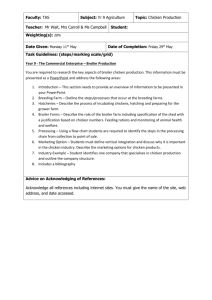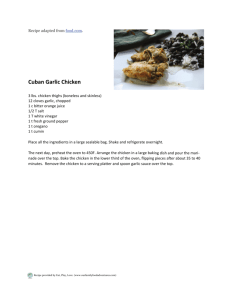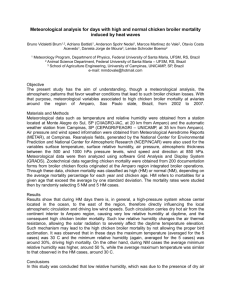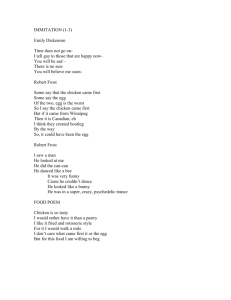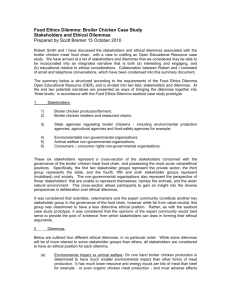Chicken Products Buyer's Guide: Frozen & Uncooked
advertisement
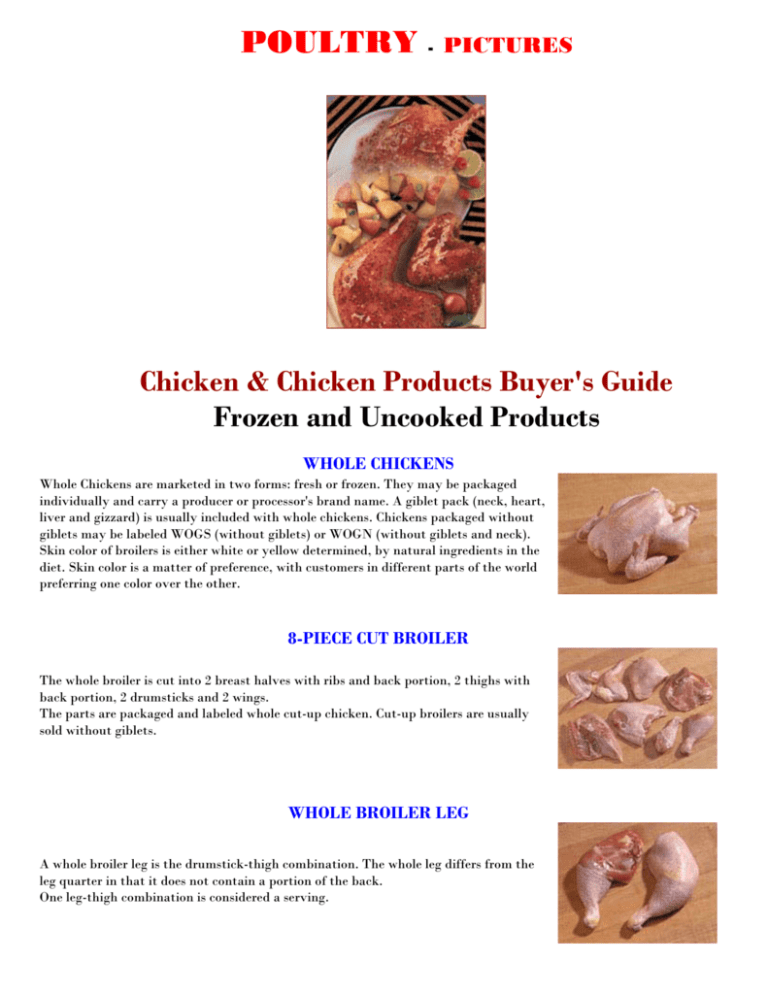
POULTRY - PICTURES Chicken & Chicken Products Buyer's Guide Frozen and Uncooked Products WHOLE CHICKENS Whole Chickens are marketed in two forms: fresh or frozen. They may be packaged individually and carry a producer or processor's brand name. A giblet pack (neck, heart, liver and gizzard) is usually included with whole chickens. Chickens packaged without giblets may be labeled WOGS (without giblets) or WOGN (without giblets and neck). Skin color of broilers is either white or yellow determined, by natural ingredients in the diet. Skin color is a matter of preference, with customers in different parts of the world preferring one color over the other. 8-PIECE CUT BROILER The whole broiler is cut into 2 breast halves with ribs and back portion, 2 thighs with back portion, 2 drumsticks and 2 wings. The parts are packaged and labeled whole cut-up chicken. Cut-up broilers are usually sold without giblets. WHOLE BROILER LEG A whole broiler leg is the drumstick-thigh combination. The whole leg differs from the leg quarter in that it does not contain a portion of the back. One leg-thigh combination is considered a serving. WHOLE CHICKEN WING The whole wing is an all white meat portion composed of three sections: the drumette, mid section and tip. ROASTER One of the larger varieties of whole chickens, roasters may be marked with or without giblets. BROILER BREAST QUARTER Broiler halves may be further cut into breast quarters which include the wing. A broiler breast quarter, including portions of the back, is all white meat. BROILER DRUMSTICKS Broiler drumsticks include the lower portion of the leg quarter; or that portion between the knee joint and the hock. Drumsticks weigh from 4 to 5 ounces (114 to 142 grams). Two drumsticks make one serving. 9-PIECE CUT BROILER Broilers may be cut into nine pieces for marketing. The pieces include 1 breast keel portion, 2 breast sides or ribs, 2 thighs, 2 wings and 2 drumsticks. The nine piece cut broiler is marketed primarily through food service outlets and fast food restaurants. CORNISH HENS A young, immature broiler chicken of either sex, usually less than five weeks of age, weighing not more than 2 pounds. BROILER SPLIT BREAST WITH BACK A broiler breast quarter with the wing removed is marketed as the split breast. They are white meat and weigh from 12 to 15 ounces (340 to 425 grams) each. BROILER LEG QUARTER A leg quarter is the drumstick and thigh portion with one half of the portion of the back attached. Leg quarters may also include attached adominal fat and up to two ribs. CHICKEN WING PORTION MID SECTION The section between the elbow and the tip, sometimes called the wing flat or mid-joint. BROILER HALVES The broiler is split from front to back through the backbone and keel to produce 2 halves of approximately equal weight. Equal parts of backbone are present on each half. BROILER SPLIT BREAST WITHOUT BACK Remove the wing and back portion from the broiler breast quarter to produce the broiler split breast without back. CHICKEN WING PORTION MID SECTION WITH TIP The flat center section and the flipper (wing tip). CHICKEN WING PORTION DRUMMETTES The first section between the shoulder joint and the elbow. BROILER THIGHS The broiler thigh is that portion of the leg above the knee joint. The broiler thigh with back portion is produced by separating the broiler leg quarter at the knee joint. The broiler thigh without back portion is produced by separating the whole leg at the knee joint. This cut must contain no rib or back meat. BONELESS, SKINLESS THIGH MEAT The flat center section and the flipper (wing tip). GIBLETS (GIZZARD, HEART, LIVER & NECK) A giblet pack includes the gizzard, heart, liver and neck. When included as a part of the whole bird, the pieces are wrapped in paper or sealed in plastic, then stored inside the bird cavity. Giblets may also be sold separately. BONELESS, SKINLESS BROILER LEG MEAT This cut is produced by removing the skin and bone from broiler leg quarters. Coarse ground chicken is made from boneless, skinless leg meat. BONELESS, SKINLESS BREAST MEAT Breast halves that have been skinned and deboned. Each breast half is considered one serving. The pectoralis major and minor muscles may be separated to produce tenderloin and boneless breast. CHICKEN FEET, CHICKEN PAWS Chicken feet are the lower leg and foot combination with the skin and toe nails removed. Chicken paws are the foot portion only. Chicken feet and paws are packaged bulk in plastic bags. For shipment, the bags are packed into corrugated fiber cartons. PRESERVATION METHODS DEHYDRATION Dehydration removes most, if not all, moisture from the chicken. Most U.S. chicken is dehydrated by spray vacuum, roller or freeze drying methods. Once dehydrated, the powdered, chunked or granulated product may be vacuum packaged in cans or pouches that may be safely stored for use years later. Dried products, stored in poly-lined boxes and drums, have a shorter shelf life. Dehydrated products are recommended for overseas shipment. IRRADIATION Irradiation reduces pathogens sometimes found in chicken. This process can also increase the refrigerated shelf-fife of fresh chicken by one week and reduce the impact of temperature abuse during export operations. Though the process is proven to be safe and reliable, irradiated poultry has not been cleared for sale in all countries. Irradiated chicken frozen and stored at 0° F (-17.8°C) is recommended for overseas shipment. BULK FROZEN Typically, these products are frozen together in containers, and individual pieces can only be removed when the entire container is defrosted. The chicken products are chilled to approximately 35° to 40° F (1.7° to 4.4° C), packed in containers and placed in a 0° F (- 17.8° C) or below freezer. The chicken products are generally frozen within 24 to 72 hours. Bulk frozen chicken products have a typical shelflife of up to 12 months if properly shipped and stored at 0° F (-17.8° C) or below. Recommended for overseas shipment. INDIVIDUALLY FROZEN The pieces are not frozen together and individual pieces can be removed while in the frozen state. The processed chicken products are frozen individually to 0° to 5° F (- 17.8° to - 15° C) before they are packed in the shipping containers and placed in a 0° F (- 17.8° C) or below freezer for storage. Individually frozen chicken products have a shelf-life of up to 12 months if properly shipped and stored at 0° F (- 17.8° C) or below. Recommended for overseas shipment. INDIVIDUALLY "QUICK" FROZEN (IQF) Individually "quick" frozen processed chicken products are quickly frozen individually to approximately 0° to 50° F (17.8° to - 15° C) within 60 minutes or less of the start of the freezing process. The pieces are frozen separately and individual pieces can be removed while in the frozen state. The use of the term "quick" frozen is governed by the United States Department of Agriculture and requires products to be placed in a freezer immediately after initial chilling or held up to 48 hours at a temperature of 36° F (2.2° C) and then frozen to 0° F (- 17.8° C) or lower within 72 hours of the start of the freezing process. Individually "quick" frozen chicken products have a shelf-life of up to 12 months or more if properly shipped and stored at 0° F (-17.8° C) or below. Recommended for overseas shipment. FROZEN STORAGE The shelf-life for plant-frozen or commercially frozen chicken products packaged and stored under proper conditions is normally 12 months. However, tests have proven that poultry, especially raw poultry, can be stored for several years with insignificant loss of shelf-life or flavor. Frozen chicken products, however, can experience various stages of damage by freezer burn, dehydration, chemical and nutritional deterioration during shipping and storage. Variables during shipping and storage that affect shelf-life are: maintenance of constant 0° F (-17.8° C) or below temperature, time, protection of products from air and freezer air velocity.
